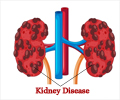Scientists at the University of Michigan Medical School have uncovered the reason for a severe form of kidney affliction and renal failure in children
Scientists at the University of Michigan Medical School have uncovered the reason for a severe form of kidney affliction and renal failure in children, which is because of mutations in a gene called phospholipase C epsilon or PLCE1.
Discovering the mutant gene is crucial to scientists because PLCE1 impacts the development of podocytes – that are unique cells that have an important role in the kidney's function in the body.To parents of infants with inherited PLCE1 mutations, the study is especially significant because it provides the first evidence that some types of a kidney disease called nephrotic syndrome, if diagnosed early in infancy, may be treated successfully in children.
'This is the first report of infants with two mutations in a recessive gene for steroid-resistant nephrotic syndrome who nevertheless responded to steroid treatment,' says Friedhelm Hildebrandt, M.D., the U-M's Frederick G L Huetwell Professor for the Cure and Prevention of Birth Defects. 'The early onset form of the disease is severe and infants often go into end-stage renal disease within the first year of life. So, until now, most physicians believed there was no point in trying treatment.'
The study will be published Nov. 5 in Nature Genetics as an Advance Online Publication, and will be printed in the journal's December 2006 issue.
There are many types and many causes of nephrotic syndrome, but basically it is a disease of the glomerulus, the kidney's main blood filtration unit. There are about one million of these filtration units in each human kidney. As blood flows through a network of tiny capillaries in the glomerulus, excess water, salts and toxic molecules are removed and flushed out in urine, while important blood proteins like albumin are retained in the bloodstream. If the kidney's filtering units don't work properly, nephrotic syndrome develops. Proteins leaking out from the glomerulus are excreted in urine, and body tissues retain too much water, which causes swelling around the eyes and throughout the body.
Some types of nephrotic syndrome can be treated with steroids or other drugs, but steroid-resistant forms of the disease as a rule do not respond to treatment. Untreated nephrotic syndrome often causes severe scarring and a condition called focal segmental glomerulosclerosis (FSGS), which progresses about 50 percent of the time to end-stage kidney disease and renal failure.
PLCE1 is the seventh gene scientists have found to be involved in different types of steroid-resistant nephrotic syndrome, and the second gene that is expressed in podocytes–specialized cells with octopus-like tentacles surrounding the glomerulus.
Podocytes are currently under intensive study, because scientists believe they play a vital role in the blood filtration process. Identifying genes and proteins that are active in podocytes will help scientists understand how they work.
'We found that PLCE1 is expressed in developing and mature podocytes,' says Hildebrandt. 'Most of the PLCE1 mutations we identified apparently prevented podocytes from developing normally in the embryo, so defects were present at birth. A milder mutation seemed to interfere with repair mechanisms in the glomerulus, so defects didn't show up until later in life.'
U-M scientists used DNA microarrays to analyze blood samples from 26 families around the world who had children diagnosed with steroid-resistant nephrotic syndrome. After eliminating known mutations, the study team was left with DNA from 12 children with the disease. All 12 had inherited recessive mutations in PLCE1 from both parents. None of the seven different PLCE1 mutations were present in the 138 control subjects in the study.
All 12 children developed symptoms of nephrotic syndrome before age four. Five children progressed to end-stage renal disease before age 5. But surprisingly, two children who received early treatment with steroids or cyclosporin A were still alive and healthy, with no symptoms of the disease.
Hildebrandt and his research team couldn't believe children with the most severe form of nephrotic syndrome had been cured of the disease. So they tracked down their physicians–one in Israel and one in Turkey–to confirm that the information was correct.
'These children were very fortunate,' Hildebrandt says. 'Their physicians told us they decided there was nothing to lose by trying a course of treatment. Based on this information, we now think that there may be a critical time window during which treatment can overcome the development defects caused by PLCE1's loss of function.'
The discovery has important implications for pediatric nephrologists and pediatricians who treat infants with nephrotic syndrome, according to Hildebrandt.
'In very early-onset nephrotic syndrome, it's important to find out if the child has mutations in PLCE1,' says Hildebrandt. 'Some infants with PLCE1 mutations might be treated successfully with steroids. It's not a golden bullet, but there's a slim chance, if the treatment is given early.
'Unfortunately, mutations in other podocyte genes, like NPHS2 – also referred to as podocin – are more common,' he adds. 'Based on all our knowledge so far, there is no effective therapy when nephrotic syndrome develops as a result of podocin mutations.'
In future research, Hildebrandt and colleagues will continue searching for the causes of nephrotic syndrome. Using zebrafish that lack working copies of plce1, they hope to identify drugs that could reverse the damage to podocytes and the glomerulus caused by the disease.
'Because PLCE1 is an enzyme, we have a much better chance of finding ways to modify its activity,' Hildebrandt explains. 'Using the zebrafish model, we can do high-throughput screening of many possible drug candidates for this form of nephrotic syndrome.' Note for parents and physicians: Information on genetic testing for infants with early-onset nephrotic syndrome is available at www.renalgenes.org.
Source-Eurekalert
SAV











